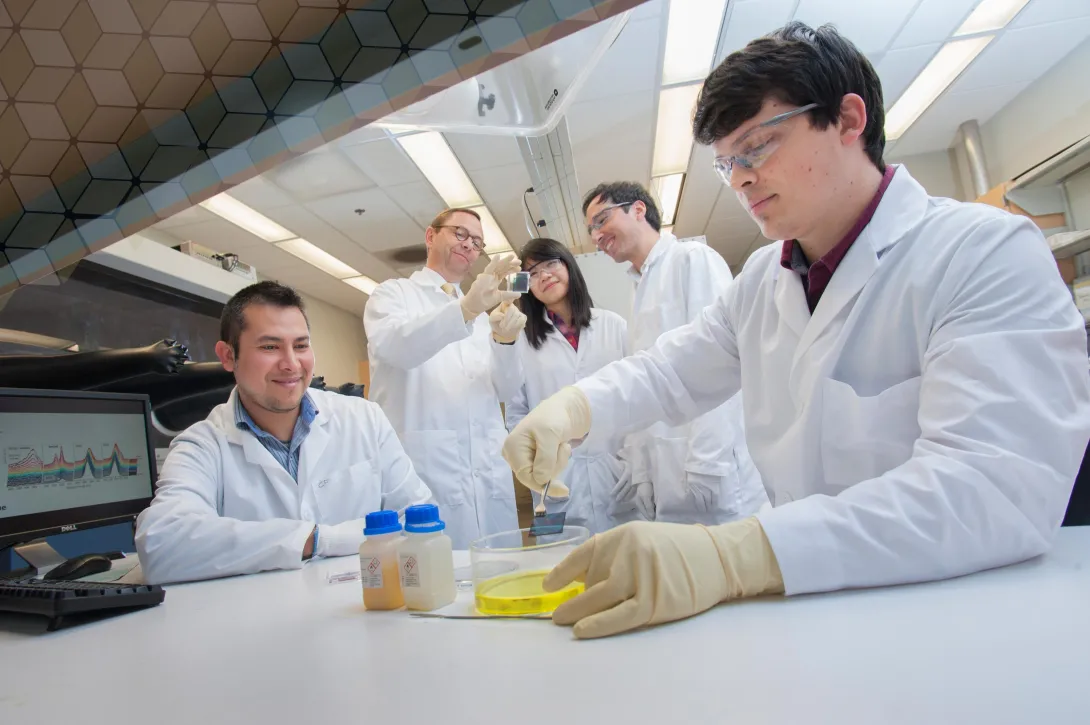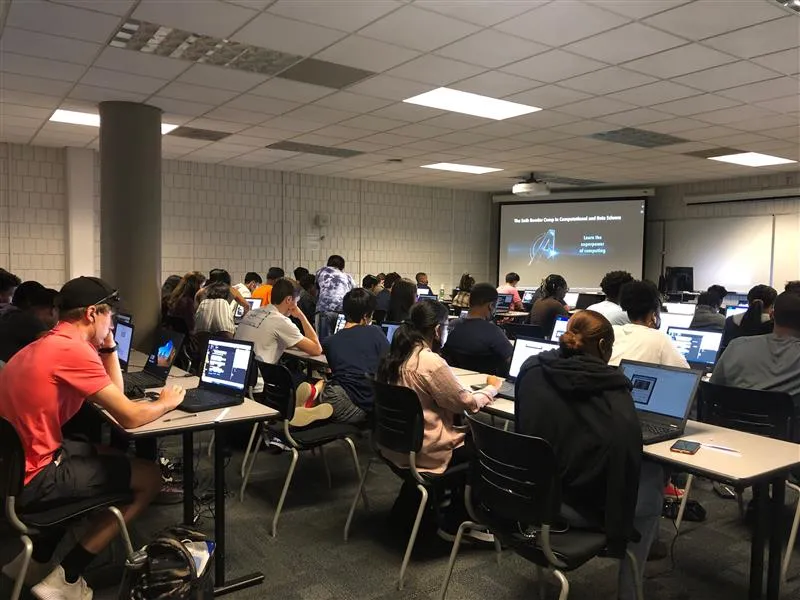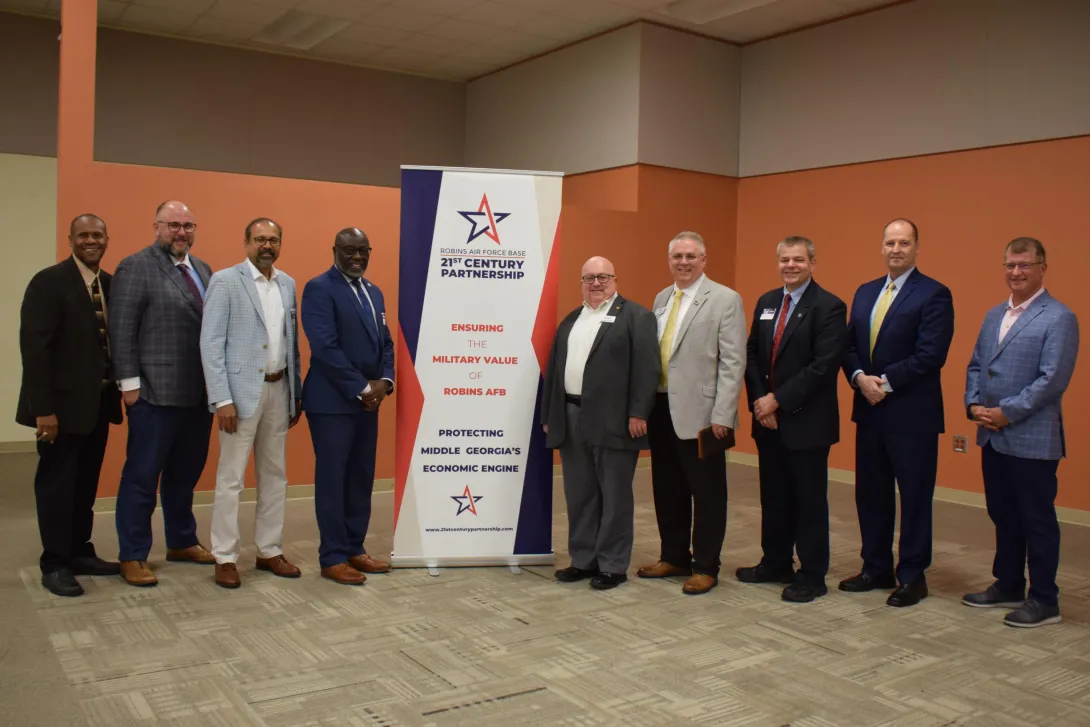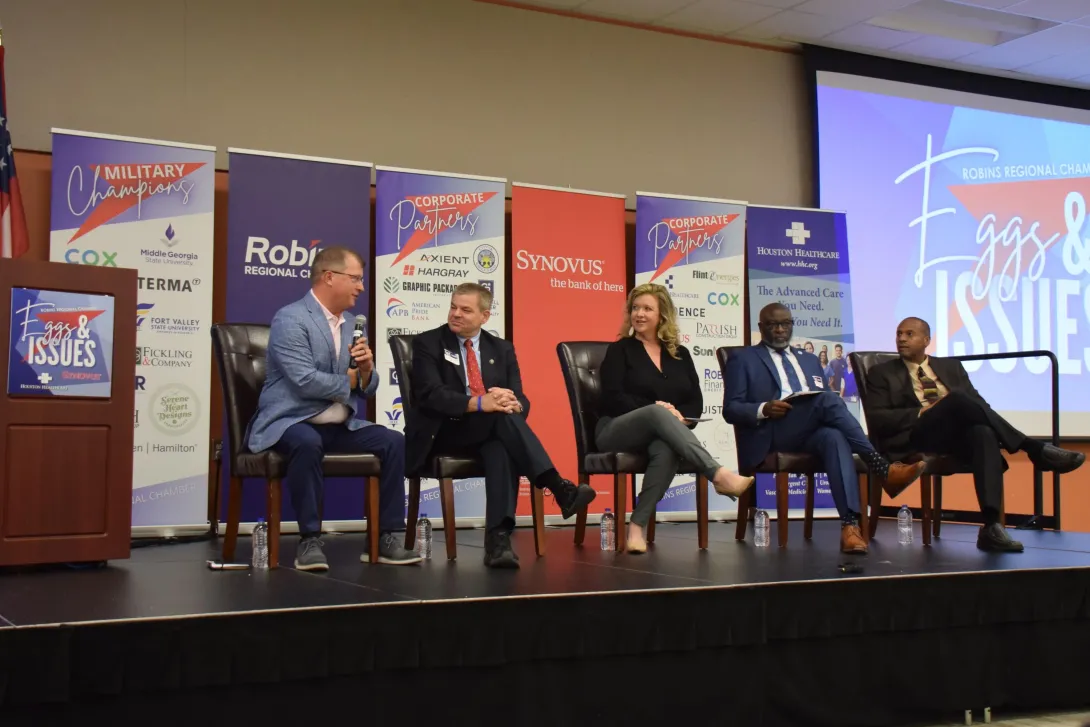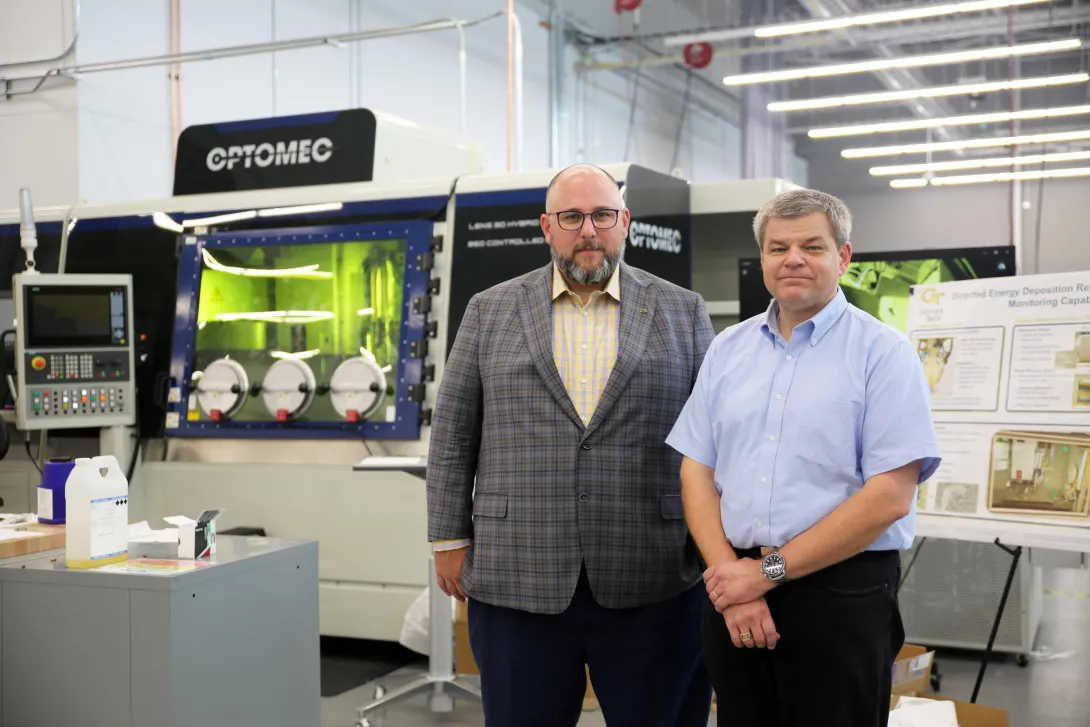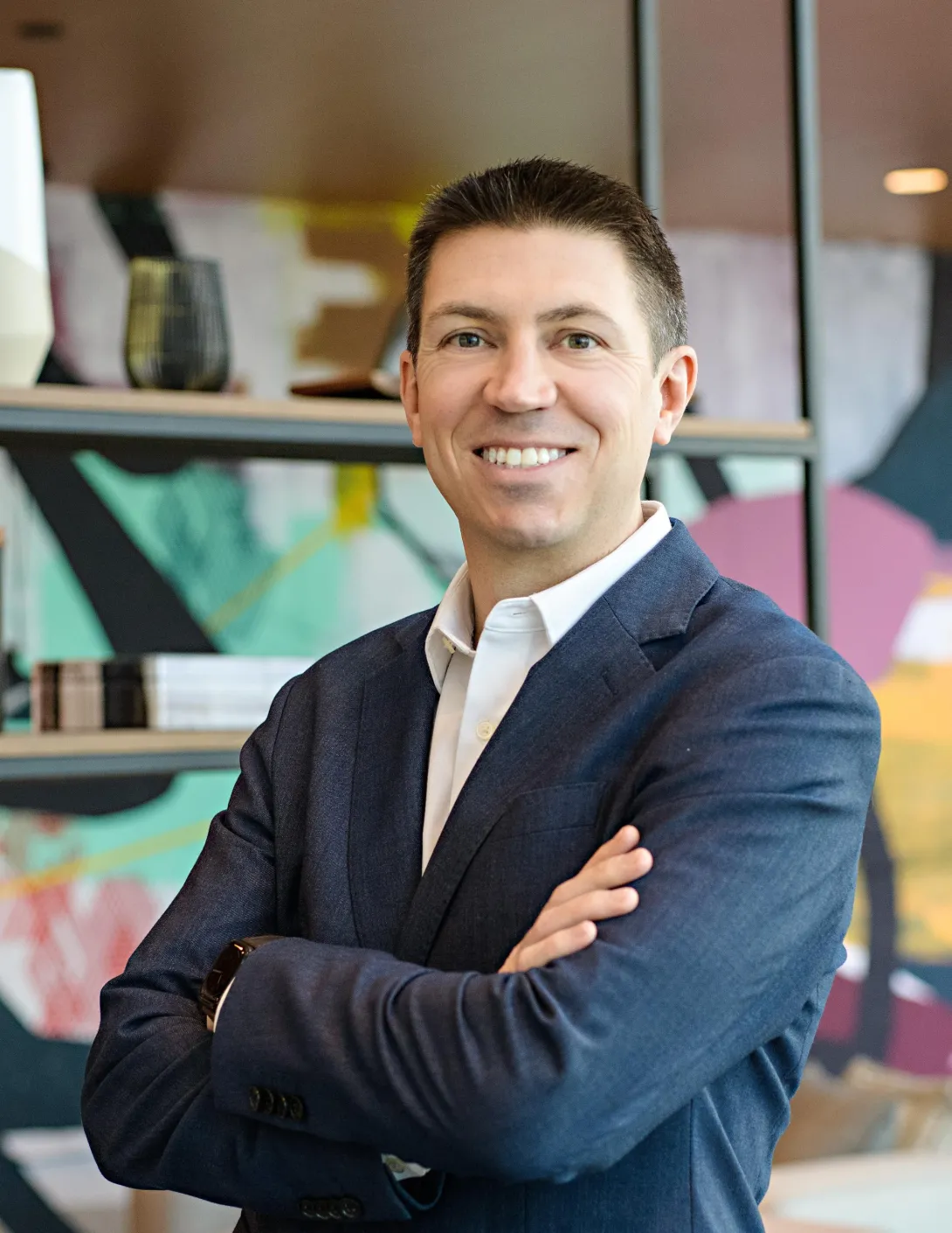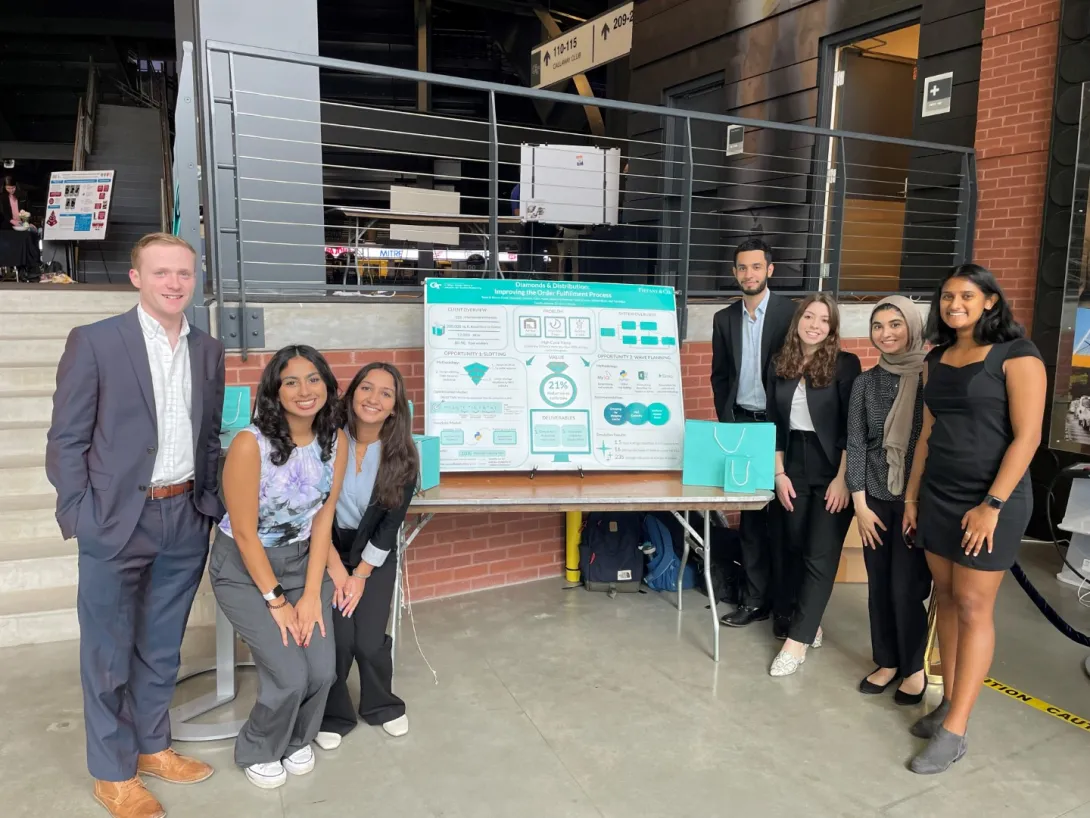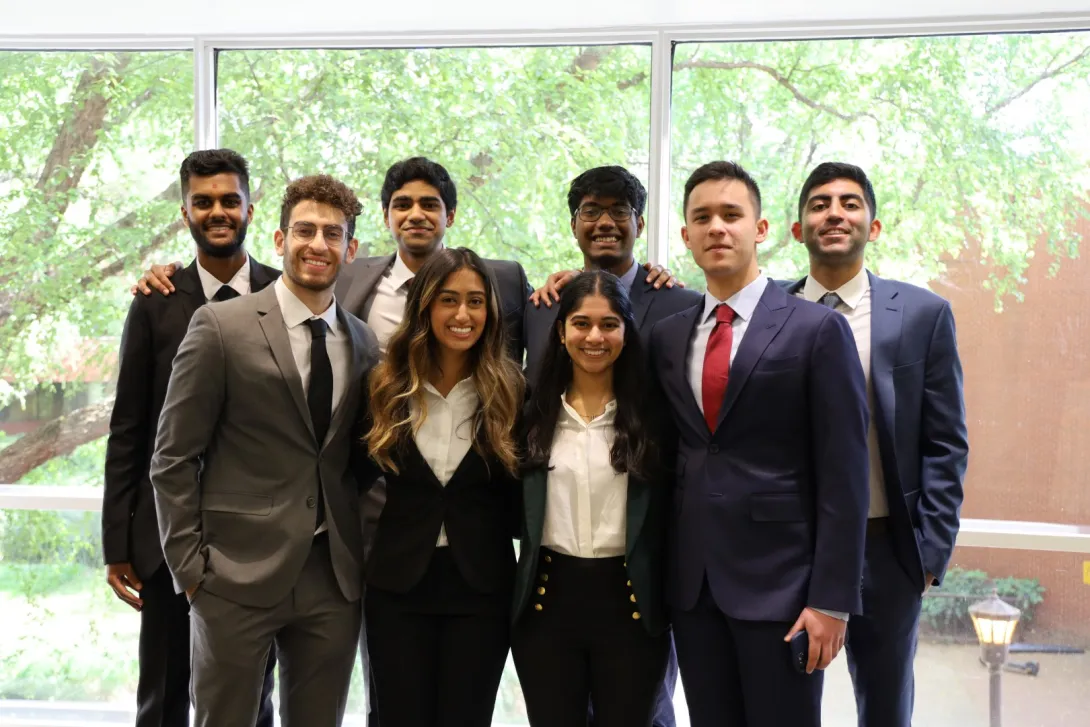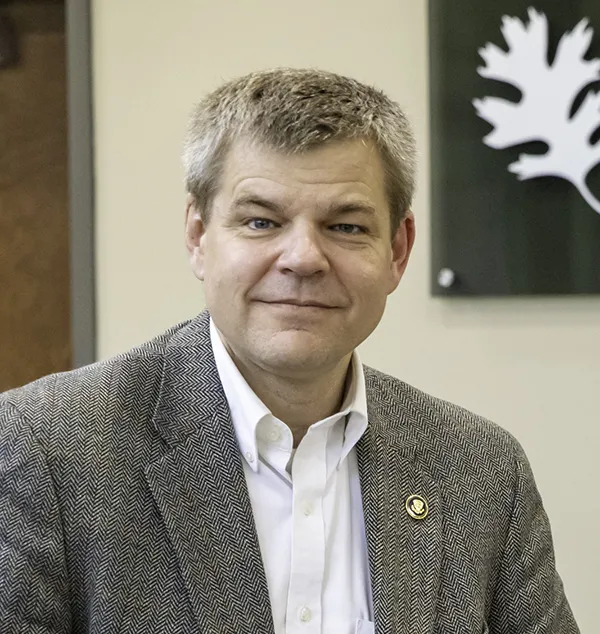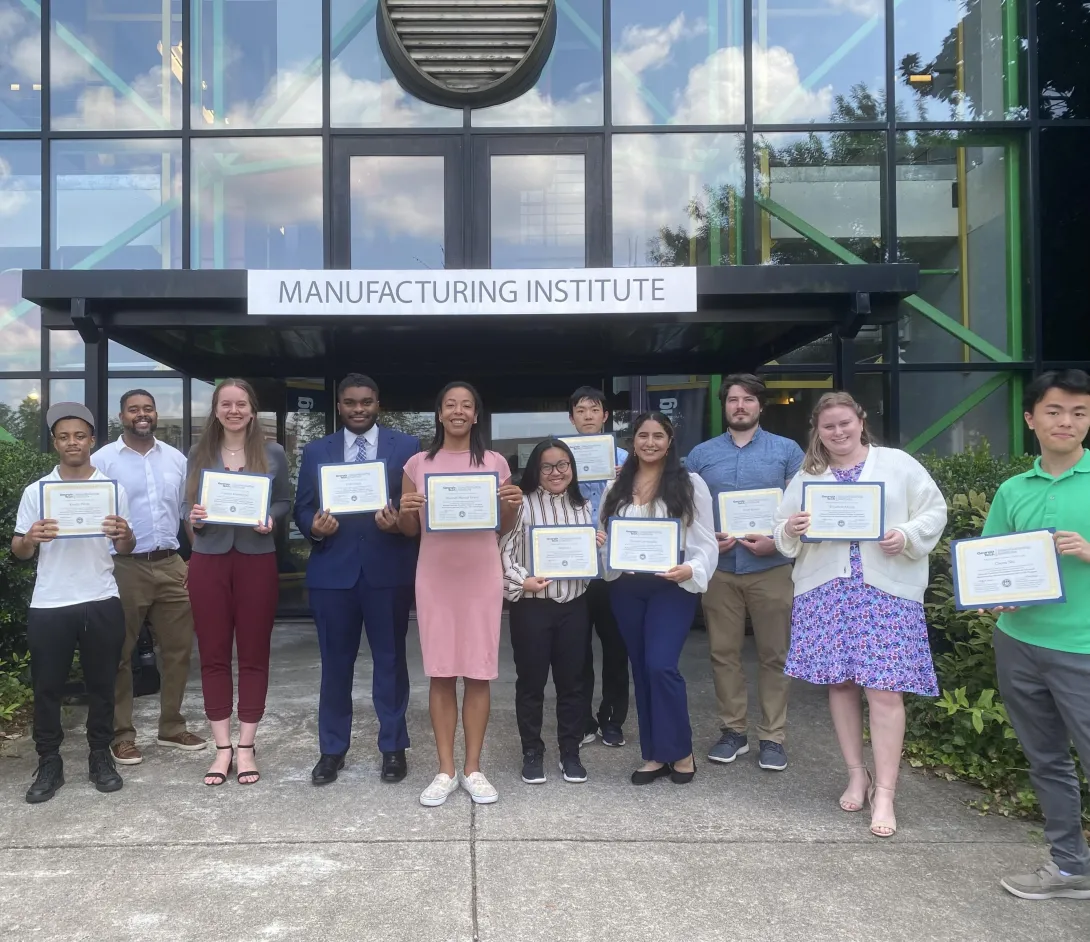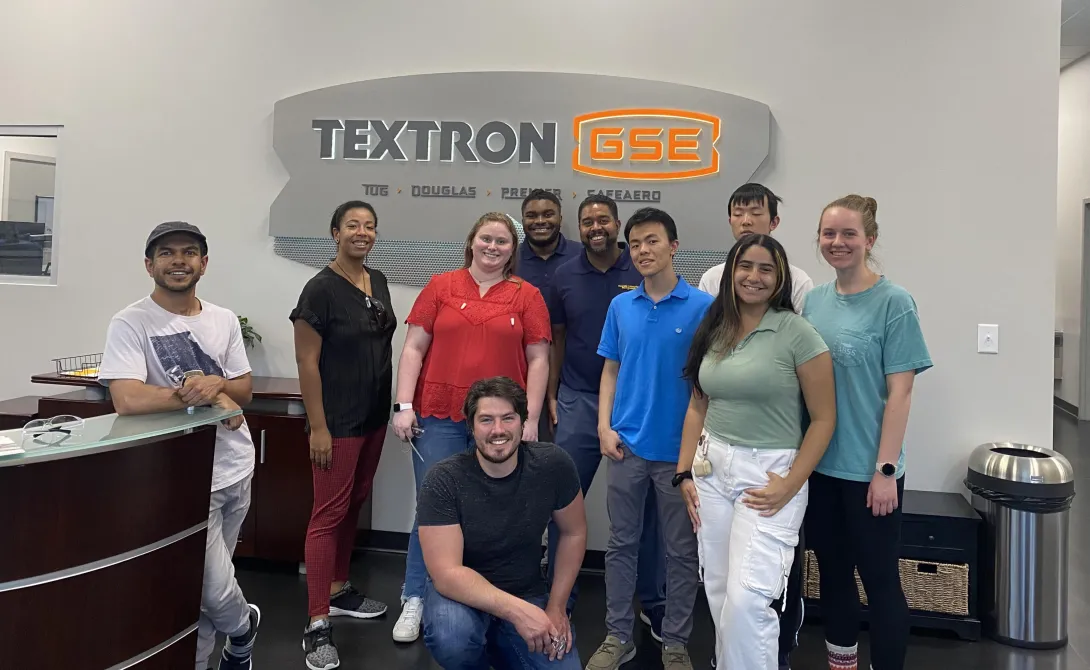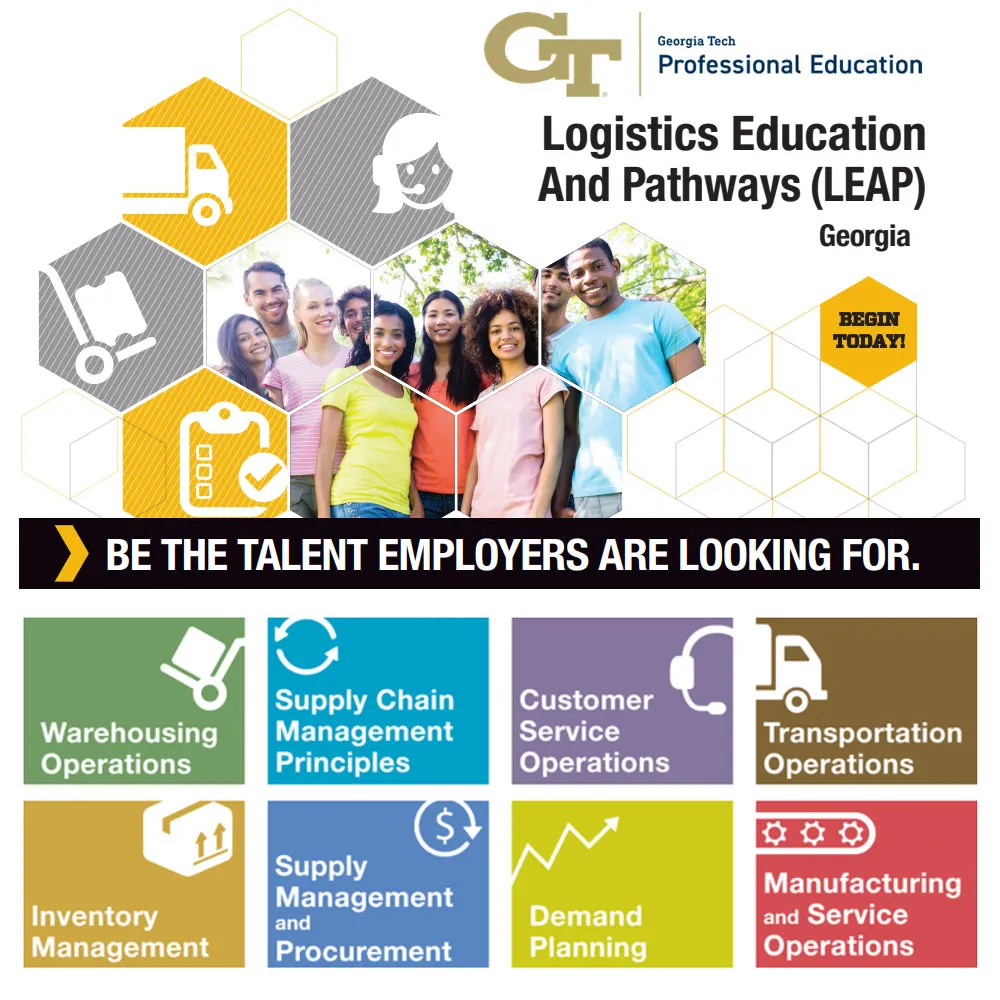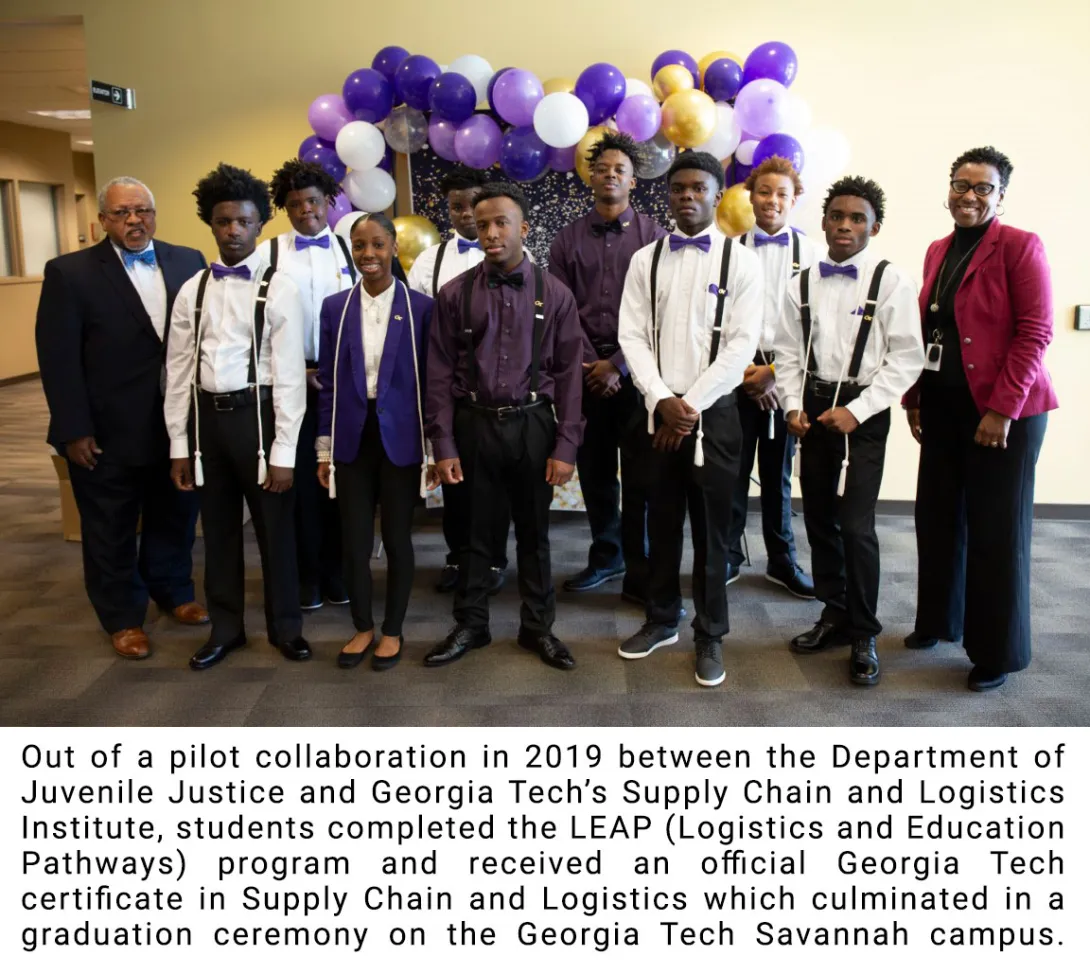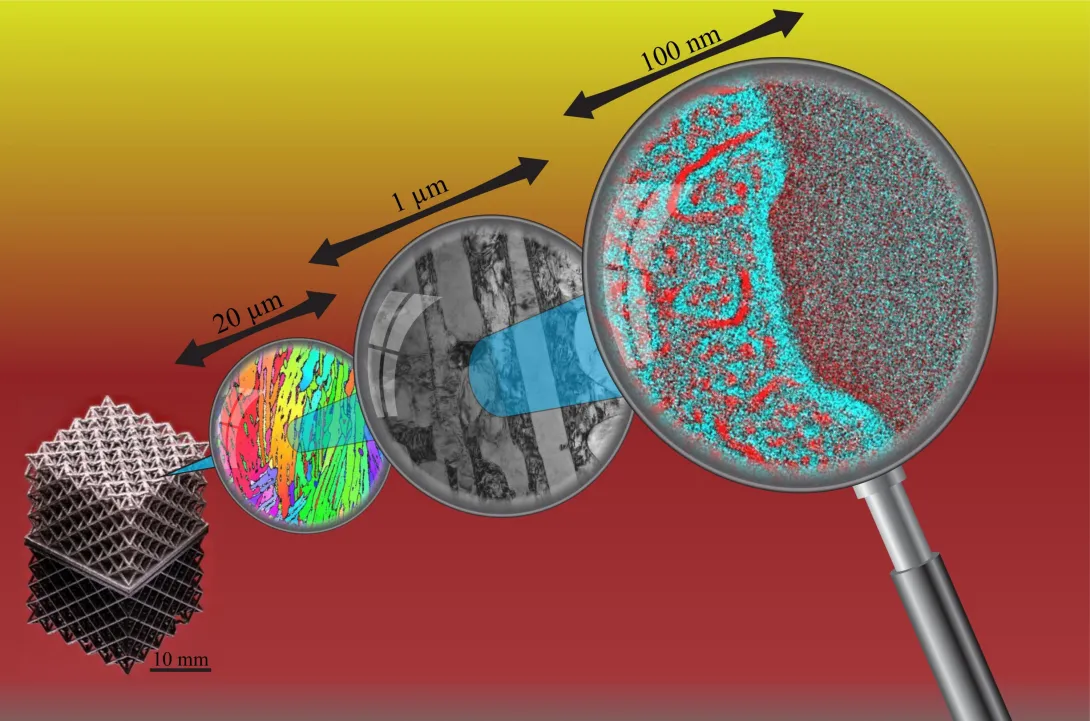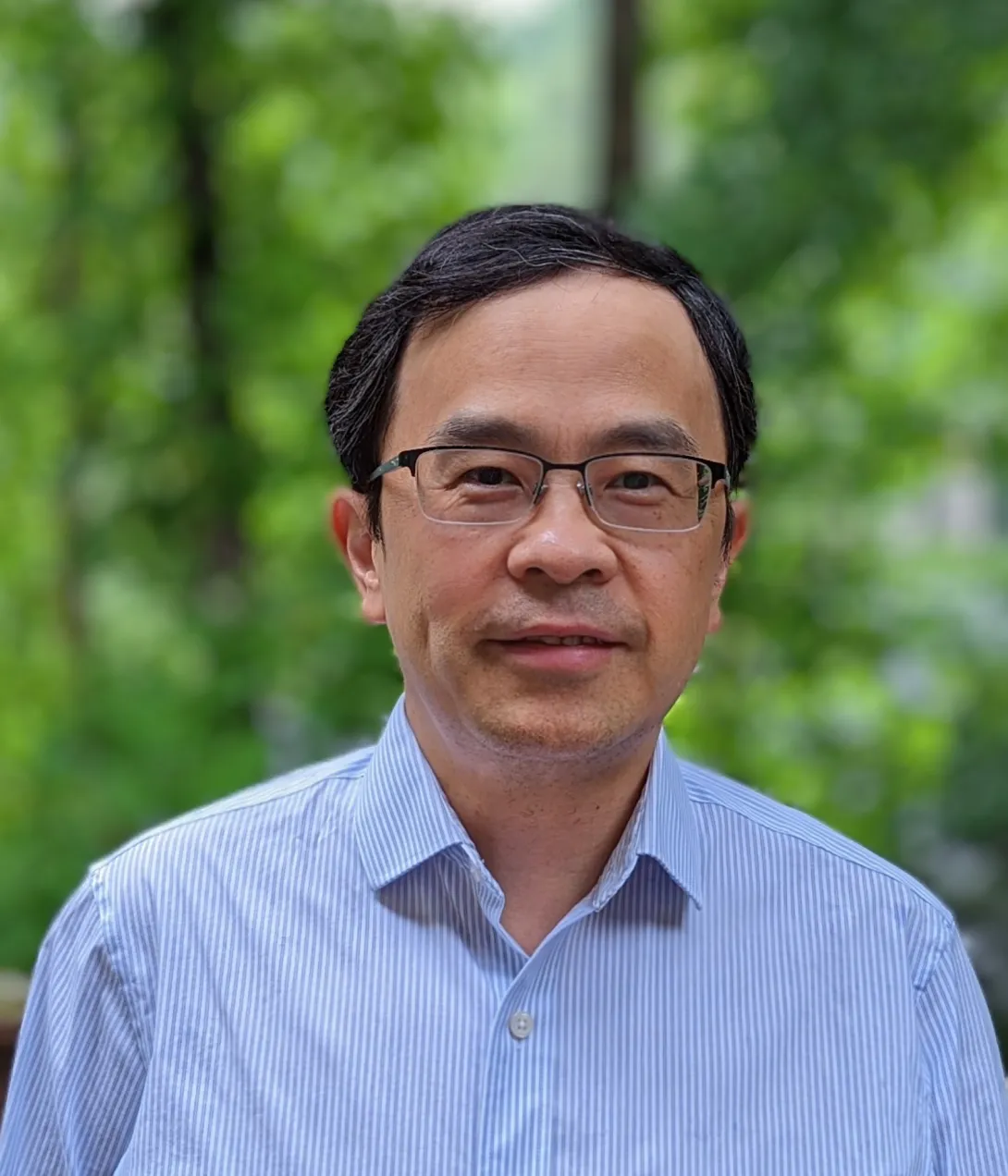Sep. 27, 2022
The Scalable Asymmetric Lifecycle Engagement Microelectronics Workforce Development program (SCALE) has announced the program will extend another five years and expand with $10.8 million additional Department of Defense (DoD) funding, with a ceiling of $99 million.
SCALE officials said this expansion of the nation’s preeminent program will further its goal to develop a next-generation workforce that can return the United States to prominence in global microelectronics manufacturing.
Georgia Tech participates in the partnership, which is led by Purdue University and managed by NSWC Crane. SCALE facilitates the training of highly skilled U.S. microelectronics engineers, hardware designers and manufacturing experts. SCALE brings together a public-private-academic partnership of 17 universities and 34 partners within the defense industry and government.
“This is an extremely exciting time in the country and at Tech for microchip design and manufacturing,” said Arijit Raychowdhury, the Steve W. Chaddick School Chair of Tech’s School of Electrical and Computer Engineering (ECE). “These newly announced funds for the SCALE program will help Georgia Tech recruit a new, diverse group of students ready to work in defense microelectronics. We’re thrilled to be a SCALE partner university and honored to be leading many of the project’s specialty areas.”
SCALE provides unique courses, mentoring, internship matching and targeted research projects for college students interested in five microelectronics specialty areas. Georgia Tech ECE faculty members will be the primary investigators for three of the areas:
- system on a chip will be led by Raychowdhury;
- radiation-hardening will be led by John Cressler;
- and heterogeneous integration/advanced packaging will be led by Madhavan Swaminathan.
The other two focus areas are embedded system security/trusted AI and supply chain awareness.
Industry and government partners regularly meet and update a list of knowledge, skills, and abilities important for new entrants to the workforce. The SCALE universities then update their curriculum to ensure the students are prepared for upcoming needs in the rapidly advancing microelectronics field.
Peter Bermel, SCALE director and the Elmore Associate Professor of Electrical and Computer Engineering at Purdue, said the United States will need 50,000 trained semiconductor engineers to meet overwhelming and rapidly growing demand.
“The United States is committed to expanding and strengthening its semiconductor industry and workforce rapidly over the next five years,” Bermel said. “SCALE takes a holistic approach to the microelectronics workforce gap by comprehensively addressing system challenges for workforce training and recruiting.”
Goals for the next five years include:
- Expanding student participation in SCALE fivefold to more than 1,000.
- Developing learning models for K-12 classrooms.
- Collaborating with community colleges nationwide to develop microelectronics classes.
The demand for microelectronics increased by 26.2% in 2021. But while the United States consumes about half of the chips produced worldwide, the country only manufactures about 12%, highlighting the pressing need for the U.S. to strengthen its domestic semiconductor supply chains and increase industrial capacity.
The funding announcement is the latest highlight in Georgia Tech’s leadership role in bolstering microelectronics and workforce development. Tech’s large engineering and science faculty bring a broad set of research expertise to strengthen the country’s semiconductor capacity. The Institute is uniquely positioned to train the microelectronics workforce, drive future microelectronics advances, and provide fabrication and packaging facilities for industry, academic and government partners to develop and test new solutions.
###
The Georgia Institute of Technology, or Georgia Tech, is a top 10 public research university developing leaders who advance technology and improve the human condition. The Institute offers business, computing, design, engineering, liberal arts, and sciences degrees. Its nearly 44,000 students, representing 50 states and 149 countries, study at the main campus in Atlanta, at campuses in France and China, and through distance and online learning. As a leading technological university, Georgia Tech is an engine of economic development for Georgia, the Southeast, and the nation, conducting more than $1 billion in research annually for government, industry, and society.
News Contact
Dan Watson
dwatson@ece.gatech.edu
Sep. 15, 2022
When Alexandria Sweeny, better known as Alex, considered what she wanted to accomplish before graduating from Drew Charter School, the then high school junior set two goals: complete her engineering internship and make a positive impact.
She did both while strengthening her coding knowledge during her time as a camper and mentor at the Seth Bonder Camp in Computational and Data Science for Engineering (SBC).
“I did it when it was fully virtual, and it was definitely an experience,” said Sweeny who spent a week being introduced to computing and data science where she performed virtual activities, last June.
The camp, which is offered either as an online course or on-campus summer camp at Georgia Tech, is designed to build students’ problem-solving and analytical skills while furthering their interest in computer science as a potential career. It is also part of AI4OPT’s mission to inspire young Georgians to pursue STEM (science, technology, engineering and mathematics).
AI4OPT hosted its first in-person summer camp at Georgia Tech in June. The camp brought together 60 students from schools across Georgia including Drew Charter, Banneker High School, and Westlake High School.
Sweeny was asked to return to this particular camp—but this time, as a mentor.
“Of course, I said yes, because it was something fun that I could do over the summer preparing for college without it being too hefty,” said Sweeny. “It was something that I felt prepared for from attending the camp.”
Responses like Sweeny’s motivates SBC Site Managers like Reem Khir to introduce more bright minds to the camp centered around computer programming logic, programming language for AI, and teamwork.
“We expose them [high school students] to certain types of education areas like Twitter analysis, how to solve a sudoku, and even computational biology, if they wanted to consider a career in biology,” said Khir, who joined the camp last year to help students with assignments. This year, she took on even bigger leadership role by maintaining and observing two camps and facilitating 50 students and seven teaching assistants (TAs). She worked under a ‘student to student and student to TA’ interactive structure so that each participant took away a useful skill in data science.
“It’s the time where high school students start forming opinions and decisions about the career path they want to pursue,” said Khir. “The steppingstone is their college education, and we can help students in that period.”
AI4OPT Will Acquire and Advance Seth Bonder Camp
AI4OPT is working to adopt a short-term system used to track students after the camp. The institute wants to build up the system to see majors, colleges, and career paths each student has vowed to pursue before they head off to college or the workforce.
“This is a critical period for students,” said Khir. “It’s a time where students start thinking about a major for college and later impacting the next 20 or 30 years of their life. Being a part of that is very unique in terms of creating a positive influence in the next generation.”
AI4OPT is taking the lead over the SBC to offer the initiative more organizational support as the program has seen tremendous growth and has become a much broader initiative. The Seth Bonder Foundation, which first introduced the camp to those ages 10-18, will continue to fund the camp now more targeted towards high school students interested in engineering, but do not have access to computer science and/or data science in their middle and high schools.
“A lot of the different communities are not exposed to this and may never see this opportunity. The Seth Bonder Camp exposes high school students to AI opportunities and gives them skills to successfully enter the field of STEM with confidence,” said Professor Pascal Van Hentenryck, who’s brought his data sciences skills and knowledge to Georgia Tech and leads both AI4OPT and the SBC.
AI4OPT is in transition to lead the SBC to offer more organizational support as the program sees tremendous growth. The research Institute will expand the longitudinal camps to engage middle and high school students in these topics, while also bringing AI education and research programs to HBCU’s and Hispanic-serving colleges throughout the nation, addressing the widening gap in job opportunities.
Though Sweeny has transitioned away from coding and transcended into research, she never stopped setting goals even now as a first-year biomedical engineering major at Georgia Tech.
“Do anything you can to take it [the SBC] even if you don't want to go into coding,” said Sweeny. “It is a good way to meet new people learn new skills, it is something that you don't necessarily have to have a love for coding to have to do it.”
To learn more about the Seth Bonder Camp in Computational and Data Science for Engineering and to partner with the camp, visit sethbondercamp.isye.gatech.edu.
(Writer’s note: This article is part of a series highlighting AI4OPT members, students, education programs and professional development testimonies.)
Sep. 09, 2022
Thomas Kurfess, executive director of the Georgia Tech Manufacturing Institute, was one of the featured panelists at the Robins Regional Chamber’s Eggs and Issues breakfast event on September 8. The topic of discussion was the Robins Air Force Base (RAFB) 21st Century Partnership.
The 21st Century Partnership, a Georgia nonprofit corporation, is the only community enterprise dedicated solely to preserving the military presence of Robins Air Force Base, while helping Middle Georgia communities prepare to avert potential efforts to marginalize the missions of the base. RAFB hires approximately 300 scientists and engineers each year.
The Eggs & Issues breakfast series, sponsored by the Robins Regional Chamber, focuses on timely topics of local interest related to their middle Georgia community. This event discussed the 21st Century Partnership’s priorities, progress, and engagement opportunities.
The panelists included:
- Brigadier General John Kubinec, USAF, retired, president and CEO, 21st Century Partnership
- Angie Gheesling, executive director, Houston County Development Authority
- Paul Jones, president, Fort Valley State University
- Ivan Allen, president, Central Georgia Technical College
- Thomas Kurfess, executive director, Georgia Tech Manufacturing Institute
Aaron Stebner, associate professor in the Woodruff School of Mechanical Engineering, and Greg King, associate vice president for economic development at Georgia Tech, were also representing Georgia Tech at the event. Kurfess, professor in the Woodruff School of Mechanical Engineering and the HUSCO/Ramirez Distinguished Chair in Fluid Power and Motion Control, regularly visits Robins Air Force Base to support a long-standing relationship with Georgia Tech.
Stebner and Kurfess are leading a $65 million U.S. Department of Commerce economic development administrative award to create a Georgia Artificial Intelligence Manufacturing Technology Corridor with the vision of collaborative innovation and economic development across all regions of the state.
News Contact
Sep. 06, 2022
Aaron Stebner outlined an aggressive plan for artificial intelligence and manufacturing when he applied for a faculty position in 2019. In his cover letter, he promised “to establish the Georgia Institute of Technology as a world leader in additive manufacturing of solid materials (ceramics & metals) R&D, especially in the fusion of data sciences and AI to create new, world-leading technologies.”
Stebner thought it would take 10-15 years of incremental steps and funding to achieve the goal. He was wrong.
Thanks to a new $65 million grant from the U.S. Department of Commerce’s Economic Development Administration, announced by President Joe Biden, Stebner’s plan will begin to become a reality — and include the entire state of Georgia and all of its manufacturing sectors from agriculture to airplanes — two years after arriving on campus.
The largest of the nine projects within the larger Georgia AI Manufacturing (GA-AIM) technology corridor grant will allow Stebner and Georgia Tech to transform the Advanced Manufacturing Pilot Facility (AMPF) into the Artificial Intelligence Manufacturing Pilot Facility (AI-MPF). The 24,000 square-foot facility on 14th Street will more than double in size after Georgia Tech and statewide GA-AIM partners were selected as one of 21 Phase II awardees in the $1 billion Build Back Better Regional Challenge (BBB) competition, part of the Investing in America’s Communities initiative under the American Rescue Plan Act of 2021.
AMPF has been a shell waiting for a vision like Build Back Better to fill it out,” said Stebner, associate professor the George W. Woodruff School of Mechanical Engineering and the School of Materials Science and Engineering. “Now we will transform the facility into one of the nation’s first manufacturing labs designed for autonomy with the goal of helping the state and the nation to be world AI manufacturing leaders.”
Read the entire story on the College of Engineering website.
News Contact
Jason Maderer
College of Engineering
maderer@gatech.edu
Aug. 30, 2022
Chris Shaver serves as the Vice President of Global Product Management for Dematic. He joined Dematic in 2020, leading the Global Vertical Strategy team before transitioning to lead the Global Product Management organization in early 2022.
Mr. Shaver brings a wide array of executive supply chain experience to SCL. Prior to joining Dematic in 2020, he built and ran the omni-channel operations organization for Chico’s FAS, a multi-billion dollar women’s apparel retail organization. Prior to his time at Chico’s FAS, Mr. Shaver spent over a decade in the management consulting industry delivering both strategic and operationally-focused supply chain initiatives to Fortune 500 organizations. Mr. Shaver is a graduate of Georgia Tech and currently resides in Atlanta, GA.
Aug. 08, 2022
We would like to congratulate two ISyE Senior Design teams for their outstanding performance in the Capstone Design competition organized by the Material Handling Industry (MHI) and College Industry Council on Material Handling Education (CICMHE).
Team "Tiffany and Co. Diamonds and Distribution: Improving the Order Fulfillment Process" won 1st place, which also comes with a monetary award of $2,000 split among the students on the team. The team worked on a project to improve Tiffany's domestic and international order fulfillment goals. After the students identified a cause for delays in the value-added services station of warehouses, they created an optimization model and a heuristic to dynamically find the most efficient location for each item. The student team also created an application that the client can utilize themselves to run the models annually.
Students: Shreya Desai | Ozashwee Ghimire | Fares Hasan | Saman Muhammad | Neha Srivatsa | William Reich | Asli Yucebilgin
Client Sponsor: Stephanie Brumby
Faculty Advisor: Dr. Gunter Sharp
Team "SAIA. SAIA-ZING UP: Evaluation of Terminal Expansion", a senior design technical competition finalist, was recognized with an Honorable Mention. The team worked with the Industrial Engineering team at Saia LTL Freight to aid in their terminal expansion implication process. Saia has set out an aggressive growth goal of opening 10-15 terminals in the next year. The model simulated a quantification of network changes as a result of additions to Saia’s network, including operational, freight flow, and cost. The system model provides Saia with proactive, data-driven insight to the impacts on their network during their terminal expansion.
Team Members: Joey Abi-Sarkis | Abhishek Mattipalli | Maya Menon | Jay Patel | Santhosh Saravanan | Abhinav Sehgal | Pooja Sharma | Yashovarman Singh
Client Contact: Ryan Madura
Faculty Advisor: Dr. Anton Kleywegt
Congratulations to both teams, their clients, and their faculty advisors.
News Contact
Aug. 23, 2022
Thomas Kurfess, executive director of the Georgia Tech Manufacturing Institute and professor in the Woodruff School of Mechanical Engineering, has been selected to chair options for a national plan for smart manufacturing. This National Academies of Sciences, Engineering, and Medicine-appointed ad hoc committee is tasked with developing options for a national plan for smart manufacturing technology development and deployment.
The committee's final report will examine technical frameworks and processes, identify possible timelines and necessary resources, and explore policies and general roles for government, industry, and academia to address near-, medium-, and long-term challenges to improve the productivity and energy efficiency of the manufacturing sector of the United States and ensure U.S. competitiveness. A particular focus will be given to system integration issues, including incorporating manufacturing science, materials science, energy science, and other critical domains.
For information gathering and community engagement, the committee will plan and organize three workshops on the following topics: (1) state of the art smart manufacturing and future directions and needs; (2) potential broader impacts of smart manufacturing; and (3) education, training, and workforce needs for smart manufacturing. Videos and materials from these public workshops will be posted online. The input received during these workshops will serve as input for the final consensus study report.
Committee members include:
CHAIR
Thomas R. Kurfess
Thomas R. Kurfess is the HUSCO/Ramirez Distinguished Chair in Fluid Power and Motion Control and Professor of Mechanical Engineering at Georgia Tech. During 2019-2021 he served as the Chief Manufacturing Officer, and the Founding Director for the Manufacturing Science Division at Oak Ridge National Laboratory. During 2012-2013 served as the Assistant Director for Advanced Manufacturing at the Office of Science and Technology Policy in the Executive Office of the President of the United States of America, where he was responsible for coordinating Federal advanced manufacturing R&D. He was President of SME in 2018, and currently serves on the Board of Governors of the ASME. His research focuses on the design and development of advanced manufacturing systems targeting secure digital manufacturing, additive and subtractive processes, and large-scale production enterprises. He is a member of the National Academy of Engineering and is a Fellow of ASME, AAAS, and SME.
He received his S.B., S.M. and Ph.D. degrees in mechanical engineering from M.I.T. in 1986, 1987 and 1989, respectively. He also received an S.M. degree from M.I.T. in electrical engineering and computer science in 1988.
MEMBER
Richard D. Braatz
Richard D. Braatz is the Edwin R. Gilliland Professor of Chemical Engineering at the Massachusetts Institute of Technology (MIT), where he is affiliated with the MIT Energy Initiative, the Department of Chemical Engineering, the Center for Biomedical Innovation, the Center for Computational Science and Engineering, and Machine Intelligence for Manufacturing & Operations. He was the Millennium Chair and Professor of Chemical and Biomolecular Engineering at the University of Illinois at Urbana-Champaign and a Visiting Scholar at Harvard University before moving to MIT. His primary research expertise is in applied mathematics and control theory and their application to the smart manufacturing of complex chemical and biological products including lithium-ion batteries, advanced polymers, vaccines, and monoclonal antibodies. Honors include the IEEE Control Systems Society Transition to Practice Award, the Technical Innovation Award from the International Society of Automation, the Engineering Research Council’s Curtis W. McGraw Research Award, and the American Automatic Control Council’s Donald P. Eckman Award. He is a Fellow of AIChE, AAAS, IEEE, and IFAC, and a member of the National Academy of Engineering. He received the B.S. from Oregon State University and the M.S. and Ph.D. from the California Institute of Technology – all in chemical engineering.
MEMBER
Jian Cao
JIAN CAO is the Cardiss Collins Professor and the founding Director of NIMSI, the university research center on manufacturing science and innovation at Northwestern University. Cao considers manufacturing as an integration platform and specializes in innovative manufacturing processes and systems, particularly dieless incremental forming process and laser processes. Cao received her Ph.D. in mechanical engineering from M.I.T. Cao is a member of the National Academy of Engineering (NAE) and an elected Fellow of the American Association for the Advancement of Science (AAAS), ASME, CIRP, and SME. Her major research awards include the ASME Milton C. Shaw Manufacturing Research Medal, SME Gold Medal, DoD Vannevar Bush Faculty Fellowship, ASME and Pi Tau Sigma Charles Russ Richards Memorial Award, and SME Frederick W. Taylor Research Medal. Prof. Cao is the Editor-in-Chief of the Journal of Materials Processing Technology. She served as Associate Vice President for Research at Northwestern University, President of the SME North America Manufacturing Research Institute, and a program director at NSF. Dr. Cao is a board member of SME Board of Directors, and of mHUB, Chicago's first innovation center focused on physical product development and smart manufacturing.
MEMBER
Krystel K. Castillo-Villar
Krystel Castillo is an expert in building an intellectual bridge between modeling and optimization of complex smart manufacturing supply chains, integrating energy efficiency and cybersecurity. As Energy VP for DOE’s Cyber Manufacturing Innovation Institute (CyManII, $130M), she leads development of Cybersecure Energy & Emissions Quantification (CEEQ), which captures embodied energy and emissions at the product level throughout the digital supply chain. CEEQ optimizes energy consumption and emissions in advanced manufacturing contributing to saving 1 quadrillion BTUs. These discoveries can revolutionize smart manufacturing and enable secure automated processes and supply chain networks. As professor she has executed 39 grants ($11M). She is the Director of the Texas Sustainable Energy Research Institute (since 2017) managing a ~$4.28M/yr. portfolio and a $50M Alliance with CPS Energy. She was inducted to the UTSA Academy of Distinguished Researchers (2021), received the GreenStar Endowed Professorship in Energy (2015), and selected to participate in the National Academy of Engineering’s 2015 U.S. FOE and 2019 E.U.-U.S. FOE symposiums.She has taught manufacturing courses for more than 12 years and mentored 24 graduate students. She has served as principal investigator in 5 training grants. She is actively recruiting and mentoring next-generation minority leaders and educators in advanced manufacturing.
MEMBER
Lili Cheng
Lili Cheng is a Corporate Vice President at Microsoft, and manages the Emerging Technology Group at Microsoft, is responsible for Conversational AI and the Industrial Metaverse in Microsoft’s Cloud and AI division. She partners with start-ups to large-scale enterprises, to identify areas of collaboration, drive innovation and deliver AI driven products and experiences. Cheng has a long history of research and AI with Microsoft. Cheng founded the Social Computing Group and Future Social Experiences (“FUSE”) Labs in Microsoft Research and works with top universities, and researcher around the world to help develop design and social science curriculum via the Microsoft Design Expo and the Social Computing Symposium. She was the Director of User Experience for Microsoft Windows and has innovated on technical infrastructure in the areas of real time data, search, and AI tools for Microsoft Azure. Prior to Microsoft, Cheng worked in Apple Computer’s Advanced Technology Group on the User Interface research team, where she developed QuickTime Conferencing and QuickTime VR. Lili serves on the advisory board for AI4All, which partners with top universities to amplify diverse AI talent, and is on the board of Connected Camps, a learning organization focused on online learning, governance, and online social interaction. She has been recognized by Time Magazine (“Future of AI”), Forbes (“Women@Forbes 2018”), Fast Company (“Most Creative People 2016”), New York University (“Tisch 50th Anniversary Creativity Award”). She has given numerous keynotes and interviews including Wired, Forbes, O’Reilly Media, SXSW. Cheng was born in Tokyo, grew up in Omaha Nebraska, and lives in the Seattle area with her husband, and has three sons.
MEMBER
James F. Davis
As Vice Provost IT, Jim has broad responsibilities for data and technology solutions in support of UCLA’s digital research and scholarship mission. Within UCLA, Jim co-sponsors the Institute for Digital Research and Education (IDRE). He also has oversight of the Office of the Chief Privacy Officer and the campus Disabilities Computing Program. Nationally, Jim has program oversight and is vice chair of the Governance Board for DOE’s Clean Energy Smart Manufacturing Innovation Institute (CESMII) and was a co-founder of the original Smart Manufacturing Leadership Coalition. He is currently on the Board of Governors of the Manufacturing Leadership Council. In Southern California he is program sponsor of Innovate@UCLA, a partnership with companies engaged in research exchanges and professional development programs in IT leadership. Jim is a Professor in UCLA’s Department of Chemical and Biomolecular Engineering where he does research and consults on AI, machine learning, intelligent systems, monitoring/control, and data/modeling systems across manufacturing industries. Jim was formerly the CIO at UCLA and The Ohio State University and was Board Chair of the Corporation of Education Network Initiatives in California (CENIC). He has past work experience with Amoco Chemicals and is a Fellow of the American Institute of Chemical Engineers.
MEMBER
Robert X. Gao
Robert Gao is the Cady Staley Professor and Department Chair of Mechanical and Aerospace Engineering at Case Western Reserve University in Cleveland, Ohio. He was the Pratt & Whitney Chair Professor in Mechanical Engineering at the University of Connecticut during 2008-2014. His research expertise includes signal transduction mechanisms, multi-resolution signal analysis, and artificial intelligence/machine learning for improving the observability of manufacturing processes and equipment to enhance product quality control. His work has led to the invention of multi-physics sensors and advanced signal processing methods for the in-situ monitoring of manufacturing processes such as plastic injection molding, sheet metal stamping, microrolling, etc. He has published 3 books, over 400 technical papers, including 190 journal articles, and received 13 patents. He is a Fellow of ASME, SME, IEEE, and CIRP, and received several awards from professional societies, including the ASME Blackall Machine Tool and Gage Award, SME Eli Whitney Productivity Award, IEEE Instrumentation and Measurement Society Technical Award, IEEE Best Application in Instrumentation and Measurement Award, etc. In 2020, he was named by SME as one of “The 20 Most Influential Professors in Smart Manufacturing”. Currently he is serving as Chair of the CIRP Collaborative Working Group on AI in Manufacturing.
MEMBER
Satyandra K. Gupta
Satyandra K. Gupta holds Smith International Professorship in the Viterbi School of Engineering at the University of Southern California. He is the founding director of the Center for Advanced Manufacturing at the University of Southern California. His research interests are computer-aided design, physics-informed artificial intelligence, computational foundations for decision making, human-centered manufacturing automation, and robotics. He has published more than four hundred technical articles in journals, conference proceedings, and edited books. He is a fellow of the American Society of Mechanical Engineers (ASME), Institute of Electrical and Electronics Engineers (IEEE), Society of Manufacturing Engineers (SME), and Solid Modeling Association (SMA). He has received numerous honors and awards for his scholarly contributions. Representative examples include a Young Investigator Award from the Office of Naval Research, CAREER Award from the National Science Foundation, Presidential Early Career Award for Scientists and Engineers, Invention of the Year Award from the University of Maryland, Kos Ishii-Toshiba Award from ASME, Excellence in Research Award from ASME Computers and Information in Engineering Division, and Design Automation Award from ASME. He has also received ten best paper awards at international conferences. He earned a Ph.D. in Mechanical Engineering from the University of Maryland. He is a member of National Materials and Manufacturing Board.
MEMBER
Susan N. Houseman
Susan Houseman is Vice-President and Director of Research at the Upjohn Institute for Employment Research. She is a labor economist whose recent research focuses on contract employment arrangements, domestic outsourcing, offshoring, manufacturing, and measurement issues in economic statistics.
She co-directs the Outsourcing Research Network, chairs the Technical Advisory Committee to the U.S. Bureau of Labor Statistics; co-directs the Labor Statistics Program at the Institute of Labor Economics (IZA) in Bonn, Germany; and chaired the National Academies of Sciences, Engineering, and Medicine, Consensus Study on Measuring Alternative Work Arrangements for Research and Policy.. She received her PhD in economics from Harvard University.
MEMBER
Jeannine Kunz
Jeannine Kunz is the Chief Workforce Development Officer for the Society of Manufacturing Engineers. A recognized expert in the field of learning and development for over 20 years, Kunz is at the forefront of workforce management issues, providing forward-thinking learning and development solutions for companies, academia, and individuals. Kunz served on the executive committee of America Makes and is a board member for the National Coalition of Career Development, Chair for National Defense Industrial Association’s Manufacturing Workforce Committee, and sits on CESMII, the Smart Manufacturing Institute, and Advanced Robotics for Manufacturing’s (ARM) Workforce Committees. In 2020, she joined the industry advisory committee for Clemson University’s THINKER graduate program, and in 2022, she was appointed as Board of Director for the Manufacturing Technology Deployment Group. “Crain's Detroit Business” recognized Kunz’s work when the publication selected her as one of its 2018 Notable Women in Manufacturing – in Michigan, as well as one of its 2019 Notable Women in Education. Kunz earned a bachelor’s degree in business and marketing with a concentration in economics from Eastern Michigan University in Ypsilanti, Michigan. She has served on EMU's Alumni Board and the Pittsburgh State University College of Technology Board of Directors.
MEMBER
Chinedum E. Okwudire
Chinedum Okwudire is an associate professor of Mechanical Engineering at the University of Michigan. Prior to joining Michigan, he was the mechatronic systems optimization team leader at DMG Mori USA. He received a PhD degree in Mechanical Engineering from the University of British Columbia in 2009. His research is in smart manufacturing, where he exploits fundamental methods from machine design, control, and computing to boost the performance of manufacturing automation systems at low cost. His research has found applications in 3D printing, machining and nanopositioning. He has received a number of awards and recognitions including the CAREER Award from the National Science Foundation; the Young Investigator Award from the International Symposium on Flexible Automation; the Outstanding Young Manufacturing Engineer Award from the SME (formerly, Society of Manufacturing Engineers); the Ralph Teetor Educational Award from SAE International; and the Russell Severance Springer Visiting Professorship from UC Berkeley. He has co-authored a number of best paper award winning papers on topics related to control, mechatronics and manufacturing. He participated in the 2014 Frontiers of Engineering Education Symposium and has recently served on a NASEM committee for Infusing Advanced Manufacturing in Engineering Education.
MEMBER
Melissa Orme
Melissa Orme, PhD, Vice President, The Boeing Company, oversees Additive Manufacturing activity across the three Boeing business units: Boeing Commercial Airplanes; Boeing Defense, Space and Security; and Boeing Global Services; including metal and polymer flight hardware, as well as research and factory aids to enable product development and increase factory efficiency. Orme is also responsible for guiding the development of the digital thread across the Additive Manufacturing value chain, and the implementation of data driven models from extracted and archived data from the digital thread, utilizing machine learning and artificial intelligence to drive efficiency, quality, and scale within the Additive Manufacturing end-to-end value stream. Other key responsibilities include the development of initiatives geared towards quantifying the positive sustainability trades associated with Additive Manufacturing.
Orme has a diverse professional background and began her career in academia, where she rose to the rank of Full Professor at the University of California, Irvine. In that capacity she developed her internationally renowned research program on net-form manufacturing, where her research resulted in numerous peer reviewed journal articles and 15 U.S. patents. Later, she transitioned to small business, where she served as Chief Technology Officer of Morf3D, a qualified supplier of Additively Manufactured flight hardware to Boeing and other Aerospace and Defense companies. Hence, she has deep experience in technology development through the diverse frameworks of academia, small business, and large corporations. Orme received her PhD, M.S., and B.S. in Aerospace Engineering from the University of Southern California.
MEMBER
Nancy R. Sottos
Nancy Sottos is the Maybelle Leland Swanlund Endowed Chair and Head of the Department of Materials Science and Engineering at the University of Illinois Urbana Champaign. She is leader of the Autonomous Materials Systems (AMS) group at the Beckman Institute for Advanced Science and Technology and holds appointments in the Aerospace Engineering and Mechanical Science and Engineering at Illinois. Her research group develops polymers with biologically inspired autonomous functions such self-healing and regeneration, self-reporting, and self-protection to improve reliability and extend material lifetime. Current research focuses on new energy efficient methods to manufacture polymers and composites with sustainable end-of-life strategies. She is a member of the American Academy of Arts and Sciences, the National Academy of Engineering, and the National Academy of Sciences. She joined the Illinois faculty in 1991 after receiving her B.S. and Ph.D. degrees in Mechanical Engineering from the University of Delaware.
MEMBER
William F. Spriggs
William Spriggs is a professor in, and former Chair of, the Department of Economics at Howard University and serves as Chief Economist to the AFL-CIO. In his role with the AFL-CIO he chairs the Economic Policy Working Group for the Trade Union Advisory Committee to the Organization for Economic Cooperation and Development, and serves on the board of the National Bureau of Economic Research. He is currently, the president-elect of the Labor Employment Research Association, and serves as the Vice Chair of the Board of MDC Inc (Durham, NC). He serves on the Advisory Boards of WorkRise (of the Urban Institute) and the Opportunity and Inclusive Growth Institute of the Federal Reserve Bank of Minneapolis. From 2009 to 2012, Bill was appointed by President Obama, and confirmed by the U.S. Senate, to serve as Assistant Secretary for the Office of Policy at the United States Department of Labor. Some of Bill’s previous work experience includes serving as an Economist for the Democratic staff of the Joint Economic Committee of Congress; and, as staff director for the independent, federal National Commission for Employment Policy. He is a member of the National Academy of Public Administration and the National Academy of Social Insurance; and the 2016 recipient of NASI’s Robert M. Ball Award for Outstanding Achievement in Social Insurance
MEMBER
John W. Sutherland
John W. Sutherland is Professor and Fehsenfeld Family Head of Environmental and Ecological Engineering at Purdue University. Prior to assuming his present position in 2009, he was the Henes Chair Professor of Mechanical Engineering and Director of the Sustainable Futures Institute at Michigan Technological University. He received his B.S., M.S., and Ph.D. degrees from the University of Illinois at Urbana-Champaign. He is one of the world’s leading authorities on the application of sustainability principles to design, manufacturing, and other industrial issues. He has contributed pioneering research and education achievements, and provided leadership to advancing the field of environmentally responsible design and manufacturing. He has served as an investigator on numerous government and industry research projects and has mentored more than one hundred students to the completion of their graduate degrees. He has published over 400 papers in various journals and conference proceedings. Sutherland is a Fellow of SME, ASME, CIRP, and AAAS. His honors and recognitions include the SME Outstanding Young Manufacturing Engineer Award, Presidential Early Career Award for Scientists and Engineers, SAE Ralph R. Teetor Educational Award, SME Education Award, SAE International John Connor Environmental Award, ASME William T. Ennor Manufacturing Technology Award, SME Gold Medal, and AEESP Frederick George Pohland Medal.
MEMBER
Karen A. Thole
Karen A. Thole holds the title of University Distinguished Professor of Mechanical Engineering at the Pennsylvania State University where she directs the Steady Thermal Aero Research Turbine (START) Lab, which focuses on advancing gas turbines for power generation and for sustainable aviation propulsion. Her research is aimed at increasing turbine efficiencies through improving turbine cooling technologies. She uses additive manufacturing to more rapidly advance cooling technologies as well as integrate instrumentation to make measurements not previously possible. Dr. Thole formerly served as the Department Head of Mechanical Engineering at Penn State in which she led the initiation of an online Masters degree in Additive Manufacturing and Design. She is a Fellow of ASME and AIAA. ASME has recognized her impacts with the Heat Transfer Memorial Award and George Westinghouse Gold Medal. In addition, AIAA has recognized her with the Air Breathing Propulsion Award and Thermophysics Award. Dr. Thole holds a Bachelor of Science and Master of Science in Mechanical Engineering from the University of Illinois at Urbana-Champaign, and a Doctorate in Mechanical Engineering from the University of Texas at Austin. She has served on NASA’s National Aerospace Committee and has been a member of two National Academy of Engineering studies including one on low carbon aviation and the other on identifying research needs to advance gas turbines.
News Contact
Aug. 16, 2022
Ten students, including a U.S. Navy veteran, graduated from the 2022 Research Experience for Student Veterans in Advanced Manufacturing and Entrepreneurship (REVAMP) summer program. This student and veteran-focused program is funded by the National Science Foundation (NSF) and hosted each summer by the Georgia Tech Manufacturing Institute (GTMI). GTMI serves as a Research Experience for Undergraduates (REU) site for NSF.
The leader of this REVAMP REU education and work force development (EWD) program is Billyde Brown, Ph.D., EWD director at GTMI and senior research faculty member. Throughout the year, Brown’s role is to create strong partnerships among industry, government, and academia in manufacturing research, development, and deployment while acquiring and managing sponsored research programs. Chuck Zhang, the Harold E. Smalley Professor in the H. Milton Stewart School of Industrial and Systems Engineering and a GTMI-affiliated faculty, serves as the principal investigator of the REVAMP REU program.
Students in the 2022 summer cohort explored a variety of manufacturing research projects with faculty and graduate student mentors from Georgia Tech’s College of Engineering including ceramic 3D printing for bioabsorbable orthopedic implants, metal 3D printing of thixotropic alloys, wireless electrochemical biosensors for bioreactor process monitoring, machine learning and neural networks for optimization of 3D printing and maker-space utilization, slot-die process for large-area polymer coatings, nanowire production, wood composites for green and energy efficient buildings, and microfluidic devices for cell media replacement.
According to participant Valeria Carrasquillo, “I had the opportunity to be a student in the REVAMP Program where I worked with many amazing people and learned a lot through the research.” She is an undergraduate at the University of South Florida majoring in biomedical engineering.
Previous students have performed fundamental research projects in advanced manufacturing topic areas such as additive and hybrid manufacturing, composite joining and repair, cell therapy manufacturing, robotic machining, integrated computational materials engineering, Internet of Things (IoT) sensors, data analytics for adaptive manufacturing, and nanoscale 3D printing.
REVAMP’s major program activities include a seminar series covering a broad array of manufacturing-related topics presented by Georgia Tech faculty and graduate students, external manufacturing plant tours, experiential learning classes on the fundamentals of evidence-based entrepreneurship provided by Georgia Tech’s VentureLab and/or Advanced Technology Development Center (ATDC), a panel discussion from successful minority business enterprise clients of the Minority Business Development Agency (MBDA) Center in Atlanta, and three oral presentations delivered by students to demonstrate their research progress.
A new program element started in 2019 that offered a student veteran orientation, panel discussions, luncheon events, and tours of Georgia Tech Research Institute (GTRI) facilities both on the main campus and Marietta locations that were facilitated together with GTRI veteran faculty and the Georgia Tech Veterans Resource Center director. REVAMP is one of the premier REU programs in the nation for advanced manufacturing research and entrepreneurship training for undergraduate student veterans.
“For the past ten weeks, I have been a part of the National Science Foundation (NSF) REVAMP-REU [program] at Georgia Tech. I worked with Dr. Mark Losego, Dr. Nicolas Somers, and Dr. Alejandro Montón Zarazaga on optimizing the ceramic printing process. I also had the opportunity to work with Brandy Nagel on connecting research to entrepreneurship using the NSF I-Corp model. I am incredibly thankful that I was able to be part of such an amazing program,” said Betsy Moore, a student at Washington and Lee University studying integrated engineering with biology.
This year’s REVAMP-REU 10-week summer program was held from May 25 – August 3 at GTMI located on the Georgia Tech campus.
Students worked under the supervision of different faculty mentors to complete a research project centered on cutting-edge manufacturing science and technology. They also received entrepreneurship training by conducting customer discovery interviews to support a hypothetical product related to their research. As a bonus, eligible students received on-campus housing, $500 towards travel, and a $5,000 stipend.
Congratulations to these student graduates (in bold text) of the summer 2022 REVAMP REU program:
Angela Li
Project: “Mechanical Characterization of Silica Microcapsules for Nanowire Production”
Research mentors: Calib Lanier, Michael A. Filler
Shannan Merced Moore
Project: “Strain-induced Refinement of Grain Size in 3D Printed Zinc Alloys”
Research mentors: Sairam Jaishankar, Dongang Yao
Cobe Smart
Project: “Multi-functional Multi-layer Film Coating on Roll-to-Roll Manufacturing System”
Research mentors: Minwoo Jung, Tequila Harris
Elizabeth (Betsy) Moore
Project: “New Innovative Processes for Additive Manufacturing of Ceramics”
Research mentors: Nicolas Somners, Alejandro Montón Zarazaga, Mark Losego
Kweku White
Project: “Machine Learning to Improve Makerspace Safety and Accessibility”
Research mentor: Amit Jariwala
Owen Shi (and Luka M.)
Project: “Gaussian Mixture Model Multiphysics Simulation for Physics-constrained Neural Network in Additive Manufacturing”
Research mentors: Luka Malashkhia, Jungin Kim, and Yan Wang
Ruoyu (Carl) Li
Project: “A Biosensor for Automating Real-time Therapeutic Cell Growth”
Research mentors: Zhaonan (Zeke) liu, Chuck Zhang
Valeria Carrasquillo
Project: “Wireless Electrochemical Sensor Capsule for Real-time Monitoring in Bioreactors
Research mentors: Aekansh Goel, Eric Vogel, and Billyde Brown
Corinne Drabenstott
Project: “Analysis of Mixing in a Microfluidic Device for Cell Buffer Exchange”
Research mentors: Steven Swingle, Avi Gupta, Todd Sulchek
Tyrel Keener
Project: “Wood-Based Composite for Thermal Management of Buildings”
Research mentors: Yongsong Huang, Akanksha Menon, Kyriaki Kalaitzidou
News Contact
Aug. 05, 2022
The Georgia Tech Supply Chain and Logistics Institute (GT-SCL) residing in and supported by the Stewart School of Industrial and Systems Engineering (ISyE), in coordination with Georgia Tech Professional Education (GTPE), is expanding its Logistics Education And Pathways (LEAP) program with the Georgia Department of Juvenile Justice (DJJ) Reentry Program to implement services for eligible participants in Chatham, Bibb, and Muscogee Education Transition Centers (ETC).
The goal of the ETCs is to reduce recidivisms and enable participants with the tools, training, and opportunities to move forward as a productive member of society with sustainable employment and a rewarding career. LEAP is a fast-paced certification program that prepares secondary education students to compete for successful high-growth jobs in the supply chain and logistics field, an outcome that is a natural component to the mission of the ETCs.
“I want to thank Georgia Tech for being a great corporate partner in rehabilitating our justice-involved youth,” said Tyrone Oliver, Commissioner of the Georgia Department of Juvenile Justice. “The LEAP program will help our youth gain valuable skills to aid them towards a brighter future.”
Initially, this partnership began with a pilot program in July of 2019, and culminated when the DJJ’s Chatham ETC hosted their Award Certification Ceremony on the Georgia Tech’s Savannah campus. Expanding this program in 2022 will equip students not only in Chatham County, but now in Bibb and Muscogee Counties with the knowledge, skills, and credentials for careers in the fast-growing Supply Chain and Logistics industry. All the funding for the LEAP program comes from industry partners like the GA Power Foundation, Schneider Foundation and JP Morgan Chase & Co. In addition, DJJ also contributed funding for this successful partnership with the ETCs.
The LEAP program initially covers understanding with the Supply Chain Management Principles course and then the various domains within the supply chain through three other optional courses (i.e., Customer Service, Warehousing Operations, and Transportation Operations). It also explores with students how the supply chain supports organizations’ strategic and financial goals, and current events through subject matter lectures and simulation exercises.
After completing the program, students receive an official GTPE Certificate of Completion for each completed pass/fail LEAP course (Supply Chain Management Principles, Customer Service Operations, Transportation Operations and Warehouse Operations), that are all sanctioned by the Board of Regents of the University System of Georgia. Typically, at their end-of-program, there is an Award ceremony where they receive their professional education certificate from Georgia Tech Professional Education (GTPE).
“While earning GT Professional Education credentials, attending fieldtrips to Gulfstream, GA Ports Authority, Amazon, or Dynacraft and improving their potential to secure employment in the exploding Savannah Supply Chain Industry, may have served as the initial motivation to attempt the program, the impact was immeasurable. Our students grew in areas that enhanced their self-confidence, work ethic, and intrinsic motivation. As a result, our students view themselves as productive citizens with credentials for quality jobs or careers in their future,” said ArtLisa Alston-Cone, Lead Teacher, DJJ Chatham ETC.
Students have a working knowledge of the fundamentals of Supply Chain and Logistics and will be immediately prepared for internships and job opportunities. Two students completed more than one course, indicating their interest and aptitude in this field. One student who was already working in a distribution operation actually completed four courses, earning a Logistics Fundamentals Program Certificate. After the program in December of 2019 with the DJJ’s Chatham ETC, seven of the eleven graduates received job offers, and another two were scheduled for interviews, making the program a great success. The students in the ETC’s have completed all requirements from the juvenile system. They are in transition to becoming productive members of society. At this point, many students are completing their High School Diploma requirements for graduation or getting their GED. They are typically living with family, a guardian or in a transition home.
“We’ve all had times in our lives when someone has discounted us, intentionally or unintentionally. There will always be that student in the corner who you think couldn’t care less, but given the proper attention and care, they can become a star. It’s easy to predetermine what someone is capable of doing; but when these students take this program, the lightbulb goes off, and they become interested and develop a passion and confidence because of this course,” said Charles Easley Jr., GT-SCL Project Director and Instructor.
The program is delivered in a cohort format so that the students always feel supported not only by the instructors but by their classmates as well. Students receive educational content but also learn how to integrate their training in the real world, so they are prepared to perform in the workplace. Students are taken on field trips with the support of community partners to learn how to apply their knowledge and see first-hand how the supply chain operates. In previous years, students were taken to Georgia Tech’s Atlanta campus to explore The Ferst Center for the Arts, The Supply Chain and Logistics Institute, and The H. Milton Stewart School of Industrial and Systems Engineering (ISyE) so they could see what options are open to them for their future working careers. During these visits they were able to participate in student information sessions, see the innovative technology in the ISyE Physical Internet Lab and interact with faculty like Benoit Montreuil, Tim Brown, GT-SCL, and role models like Gen. Ron Johnson, Professor of the Practice, and ISyE Student Ambassadors. Students were also taken to Gulfstream in Savannah and The Georgia Fair where they participated in a hands-on project to map out the supply chain process for food.
About the LEAP Program
GTSCL created LEAP in 2015 through a grant from JPMorgan Chase & Co. to further the financial services firm’s “New Skills at Work” initiative that promotes workforce development to bridge the gap between the talent employers need and the qualifications of the local talent pipeline. The curriculum and content were developed by The H. Milton Stewart School of Industrial and Systems Engineering (ISyE) at Georgia Tech. In August 2018, JPMorgan Chase & Co. continued once again committed to supporting LEAP with an additional grant. The Georgia Tech LEAP program has been delivered throughout Georgia to Schools, Cohorts, and Individual Students in 18 School Districts or Systems, at 46 different schools public and private, in 13 colleges and universities, and across several well-known organizations and employers. This includes schools like Maynard Jackson HS, Grady HS, North Atlanta HS, Effingham College Career and Career Academy, Fulton Schools College and Career Academy, Newton College and Career Academy, Social Circle HS, Griffin Region College & Career Academy, New Manchester HS; non-profit organizations like Goodwill, United Way(Career Rise), Scouts BSA(Crew 2421), The Latin American Association; and businesses like Sysco, and Mohawk Industries. The program has been continuously supported by generous donations from schools, civic organizations including Effingham College and Career Academy, Fulton Schools College and Career Academy, foundations including Home Depot Foundation, Fulton Education Foundation, Schneider Foundation, Georgia Power Foundation, Regions Foundation, and employers including companies like HMTX Industries, Inc.
News Contact
Kerry Jarvis
912-966-7913
kerry.jarvis@pe.gatech.edu
Aug. 03, 2022
A team of researchers at the University of Massachusetts Amherst and the Georgia Institute of Technology has 3D printed a dual-phase, nanostructured high-entropy alloy that exceeds the strength and ductility of other state-of-the-art additively manufactured materials, which could lead to higher-performance components for applications in aerospace, medicine, energy and transportation. The research, led by Wen Chen, assistant professor of mechanical and industrial engineering at UMass, and Ting Zhu, professor of mechanical engineering at Georgia Tech, was published in the August issue of the journal Nature.
Over the past 15 years, high entropy alloys (HEAs) have become increasingly popular as a new paradigm in materials science. Comprised of five or more elements in near-equal proportions, they offer the ability to create a near-infinite number of unique combinations for alloy design. Traditional alloys, such as brass, carbon steel, stainless steel and bronze, contain a primary element combined with one or more trace elements.
Additive manufacturing, also called 3D printing, has recently emerged as a powerful approach of material development. The laser-based 3D printing can produce large temperature gradients and high cooling rates that are not readily accessible by conventional routes. However, “the potential of harnessing the combined benefits of additive manufacturing and HEAs for achieving novel properties remains largely unexplored,” says Zhu.
Chen and his team in the Multiscale Materials and Manufacturing Laboratory combined an HEA with a state-of-the-art 3D printing technique called laser powder bed fusion to develop new materials with unprecedented properties. Because the process causes materials to melt and solidify very rapidly as compared to traditional metallurgy, “you get a very different microstructure that is far-from-equilibrium” on the components created, Chen says. This microstructure looks like a net and is made of alternating layers known as face-centered cubic (FCC) and body-centered cubic (BCC) nanolamellar structures embedded in microscale eutectic colonies with random orientations. The hierarchical nanostructured HEA enables co-operative deformation of the two phases.
“This unusual microstructure’s atomic rearrangement gives rise to ultrahigh strength as well as enhanced ductility, which is uncommon, because usually strong materials tend to be brittle,” Chen says. Compared to conventional metal casting, “we got almost triple the strength and not only didn’t lose ductility, but actually increased it simultaneously,” he says. “For many applications, a combination of strength and ductility is key. Our findings are original and exciting for materials science and engineering alike.”
“The ability to produce strong and ductile HEAs means that these 3D printed materials are more robust in resisting applied deformation, which is important for lightweight structural design for enhanced mechanical efficiency and energy saving,” says Jie Ren, Chen’s Ph.D. student and first author of the paper.
Zhu’s group at Georgia Tech led the computational modeling for the research. He developed dual-phase crystal plasticity computational models to understand the mechanistic roles played by both the FCC and BCC nanolamellae and how they work together to give the material added strength and ductility.
“Our simulation results show the surprisingly high strength yet high hardening responses in the BCC nanolamellae, which are pivotal for achieving the outstanding strength-ductility synergy of our alloy. This mechanistic understanding provides an important basis for guiding the future development of 3D printed HEAs with exceptional mechanical properties,” Zhu says.
In addition, 3D printing offers a powerful tool to make geometrically complex and customized parts. In the future, harnessing 3D printing technology and the vast alloy design space of HEAs opens ample opportunities for the direct production of end-use components for biomedical and aerospace applications.
Additional research partners on the paper include Texas A&M University, the University of California Los Angeles, Rice University, and Oak Ridge and Lawrence Livermore national laboratories.
Story by Melinda Rose, Associate News Editor at UMass Amherst.
News Contact
Catherine Barzler, Georgia Tech
Pagination
- Previous page
- 13 Page 13
- Next page
